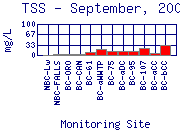 |
|
 |
|
TOTAL SUSPENDED SOLIDS (TSS)
The concentration of total suspended solids (TSS) generally increases in Boulder Creek as the creek moves downstream from the mountains to the plains (for example, see
September, 2000).  The increase in TSS is due to more erodable soils and more human influence in the lower part of the watershed. TSS concentrations at the mountain and canyon sites generally range from zero to 10 mg/L. After passing through the City of Boulder, maximum TSS concentrations increase to about 16 mg/L.
The increase in TSS is due to more erodable soils and more human influence in the lower part of the watershed. TSS concentrations at the mountain and canyon sites generally range from zero to 10 mg/L. After passing through the City of Boulder, maximum TSS concentrations increase to about 16 mg/L.
Unlike most other parameters, there is not a significant increase in TSS concentrations just downstream from the City of Boulder’s Wastewater Treatment Plant (WWTP). TSS is nearly entirely removed by treatment processes at the plant, so the addition of the wastewater effluent can actually cause TSS concentrations in the creek to decrease.
 Downstream from 75th Street to just above the confluence with Coal Creek, TSS concentrations in Boulder Creek typically remain fairly constant from site to site, and range from 1 to 40 mg/L. Sampling sites just above and below the confluence with Coal Creek are higher, ranging from 5 to 115 mg/L. These sites much receive high sediment loading to the creek, possibly from soil erosion (for example, see the graph for Boulder Creek above Coal Creek (BC-aCC) in August 1999).
Downstream from 75th Street to just above the confluence with Coal Creek, TSS concentrations in Boulder Creek typically remain fairly constant from site to site, and range from 1 to 40 mg/L. Sampling sites just above and below the confluence with Coal Creek are higher, ranging from 5 to 115 mg/L. These sites much receive high sediment loading to the creek, possibly from soil erosion (for example, see the graph for Boulder Creek above Coal Creek (BC-aCC) in August 1999).
 Unlike most other parameters, TSS concentrations in Boulder Creek do not correlate well with flow rate. However, in some years, TSS is highest in the high-flow months (May, June, July) (for example, see the graph for Boulder Creek at 61st Street (BC-61) for 1999). Fast running water can carry more particles and larger-sized sediment.
Unlike most other parameters, TSS concentrations in Boulder Creek do not correlate well with flow rate. However, in some years, TSS is highest in the high-flow months (May, June, July) (for example, see the graph for Boulder Creek at 61st Street (BC-61) for 1999). Fast running water can carry more particles and larger-sized sediment.

COMPARISON TO REGULATIONS
There is no numerical standard for surface water; Colorado Department of Public Health and Environment Water Quality Control Division (CDPHE-WQCD) regulations (5 CCR 1002-31) state that suspended solid levels will be controlled by Effluent Limitation Regulations, Basic Standards, and Best Management Practices (BMPs).